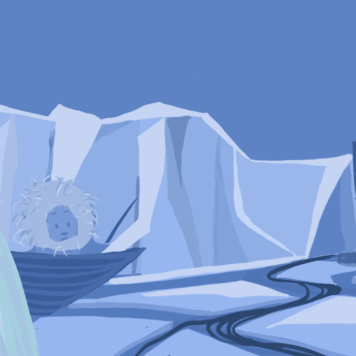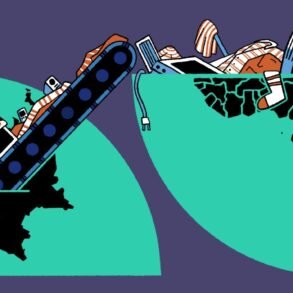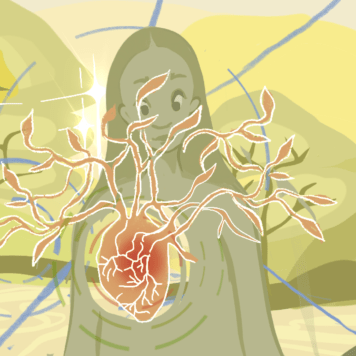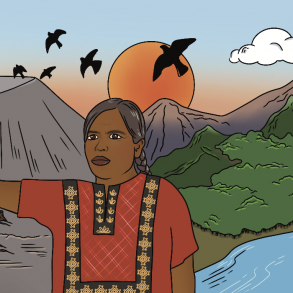As young people who grew up in a transformational information age, we receive global news on a frequent basis on the tips of our tapping fingers. We scroll and we see the good, the bad and the ugly – and soon enough, our feeds are filled with climate doom. From rampant wildfires to record-breaking floods, urgent evacuations given birth to new generations of climate refugees, the list goes on.
Frequently witnessing crisis after crisis stir feelings of frustration, anger, hopelessness and grief, and we are left to process those feelings without guidance and resources.
Researchers surveyed 10,000 young people aged 16 to 25 from 10 countries and found that three out four young people experience fear regarding what the future holds for them.
Eco anxiety is and will continue to be a common experience amongst young people and it is essential that young people who go through this experience are supported and empowered to navigate eco-anxiety through healthy means.
What is eco-anxiety?
More than feelings of fear and anxiety, eco-anxiety is all the feelings sparked by the climate crisis, its impacts and the structures that participated in constructing the crisis.
Essential systems are disappearing due to the inaction of world leaders who have the power and resources to create change.
In a future where food, water, energy and housing security is deteriorating, how can a young person feel secure about their future?
The climate crisis is worsening and it can bring out various reactions from different people. It can manifest in various emotions, behaviours and attitudes. Eco-anxiety experiences can include grief, feelings of loss, loneliness, anger, frustration, numbness, sadness and fear.
Without awareness, support and monitoring, it can lead to behaviours that can cause harm to the person experiencing eco-anxiety and the people in their lives.
Why is this a global issue?
Eco-anxiety looks different to various communities, due to different cultural, social, environmental and historical contexts.
It’s a global issue because we collectively know and understand that the consequences of the actions and inactions of more economically developed countries will be felt the harshest in countries that have historically and presently been exploited of its resources, also known as the Global South or, more correctly, MAPA (Most Affected People and Areas).
Despite mainstream narratives of eco-anxiety being dominated by activists based in Europe and the US, eco-anxiety is felt by young people from all corners of the world. The crisis is urgent and many people across the world are already facing extreme weathers and the devastations they bring to their shores.
The psychological impacts of losing your home, your source of income, source of food and stability is immense and intense to one’s mental health. Marginalised communities are facing crises that are accelerating and accumulating, these crises compound and exacerbate the experience of already living within restrictive structures of oppression – such as racism, sexism, ableism, classism, religious persecution, queerphobia, etc.
Imagine being a young person that exists within these structures and now has to face the potential of existing in an unlivable future. It’s a lot. It certainly doesn’t help that world leaders are overlooking and neglecting the needs of young people and future generations, which is why we need to build community.
To tackle eco-anxiety we need to collectively and actively build communities of care as a bare minimum. Every person on this planet deserves to have a sense of belonging, a feeling of being seen and recognised by your peers.
Communities of care can look like shared community meals, donating money to a person in crisis, peers supporting each other’s mental health, creating art with like-minded people, and so much more!
Building systems of care, allows everyone to address what their needs are and how they wish to be catered to and encourages everyone to act as a collective. We live in a capitalistic system, where we are encouraged to solve matters on our own and navigate the world as individuals.
Acting as a collective is a revolutionary act that brings revolutionary impacts.
What misconceptions or problems can exist in activist spaces?
There are harmful narratives that sometimes circulate youth activist spaces, where people can disregard their own personal needs for the sake of the greater good – the greater good being a livable and sustainable future.
Some narratives that surface in these spaces include:
- To tackle eco-anxiety, all you need to do is take action that eases the climate crisis and sacrifice rest for the sake of the greater good.
- Direct action is the only way to create significant change.
- Eco-anxiety is something that doesn’t need to be addressed as we have bigger things to deal with.
As activists and campaigners, we tend to put our needs to the side because the greater good is something worth fighting for and we are willing to do anything to get to the greater good as soon as possible.
It makes sense in theory to put short-term satisfaction to the side if it means that people will have a future where renewable energy is the new norm, where the food we eat does not have a large carbon footprint, a future where human activities do not destroy our precious and fragile ecosystems, etc. A bright, green future for all is a part of our collective vision, and if we could do anything to get it, we could do it.
However, climate spaces tend to focus on material futures and forget about the interpersonal and compassionate aspect of climate justice.
What does equity tangibly look like? How do we hold each other accountable with care? How do we eliminate the various forms of discrimination in our spaces? When someone is deeply impacted by state violence, how do we show up?
We need to ask ourselves these questions and reflect on them whilst we build these communities of care. It is vital for us to be compassionate as we dismantle the structures that systematically remove care.
If our practices are exclusionary and lack care, we have just replicated the systems and structures that we claim to fight against. It is easier said than done but we have to at least attempt to keep this thread in our work as climate justice advocates.
Who are some of the key leaders in the movement raising awareness of this?
The Resilience Project was founded by Katie Hodgetts in 2020 as a critical act of revolution.
Katie wanted to carve out spaces for young climate activists to take care of their mental health and find a community that allows them to experience joy, rest and a sense of belonging. One of the ways The Resilience Project supports young people is to train them to lead 8-week programmes in their local communities, called Resilience Circles.
The programme involves young people exchanging ways to navigate eco-anxiety and how to build resilience and reduce the chances of experiencing burnout. Since the debut of The Resilience Project, over 150 young people involved in climate activism have participated in the project and have successfully moved through the project developing themselves personally and professionally.
Alongside Katie, there are many amazing changemakers who are actively engaged in building communities of care and defining what care looks like:
- Force of Nature, a youth-led organisation supporting young people to host climate cafes, where they hold space for people to process their thoughts, feelings and experiences with eco-anxiety.
- Selin Nurgün, a somatic coach who conducts an integrative, trauma-informed, and body-based approach. They provide help to climate and social justice leaders practise the skills needed to self-regulate while working for social change.
- May Project Gardens, founded by Solomon-Kawall in 2007, a space where nature, art, creativity coincide. Solomon sees his work as a way to help people overcome personal, social and economical hardship.
In broad, some people may not directly and explicitly mention climate anxiety in their work, however, they create spaces where people can discover their sense of belonging and ease the tensions of carrying their eco-anxiety.
What can you do?
Organisations:
- Climate Psychology Alliance, climate cafes
- The Resilience Project @ourresilienceproject
- Check out our support and signposting document – https://www.theresilienceproject.org.uk/resources
- Mental Health First Aid – an organisation that provides mental health first aid trainings
- A list of mental health crisis helplines provided by Mind
Newsletters to sign up to:
- Gen Dread, a newsletter and upcoming book by Britt Wray
- Selin Nurgün, queer Turkish American, curates a regular newsletter that explores going through climate grief using tools such as somatic coaching, grief support and healing tools.
Read:
- It’s Not Just You: How to navigate Eco-anxiety and the climate crisis, book by Tori Tsui
- It’s the end of the world as we know it, and I don’t feel fine: Overcoming eco-anxiety and eco-phobia
- Book: A field guide to climate anxiety by Sarah Jacquette Ray
This article was written by Samia Dumbuya. Samia joined the Resilience Project in 2021 when they were trained to co-host a Resilience Circle in London. Samia now joins the Resilience Project organising team. Find them on socials on @samiadumbuya
Want to know more about the Resilience Project? Check out www.theresilienceproject.org.uk and follow us on Instagram to get involved @ourResilienceProject








